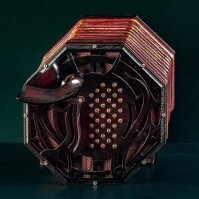
hjcjones
Members-
Posts
1,185 -
Joined
-
Last visited
About hjcjones
- Currently Viewing Forums Index
- Birthday 07/15/1954
Contact Methods
-
Website URL
https://www.howardjones.me.uk/
-
ICQ
0
Profile Information
-
Gender
Male
-
Interests
Traditional music and song, especially English.
I play Anglo: a C/G Crabb 40 key, a Dipper D/G 31 key, and Lachenal F/C baritone. Besides concertina, I play melodeon, guitar, hammered dulcimer and recorder, and sing.
I used to be in the ceilidh band "The Electropathics" and now play with Albireo -
Location
Cheshire, UK
Recent Profile Visitors
2,928 profile views
hjcjones's Achievements

Heavyweight Boxer (5/6)
-
Sorry Simon, but I don't follow what you're saying. The Coover system shows a line above the notes to be played on the draw. Line or V, what does it matter? Or do you mean you put the V markings directly above the note head, rather than above the stave? I should have thought that risks causing confusion by cluttering up the stave, but whatever works for you. All systems for writing down music, including standard notation, are to some extent a compromise. Writing for yourself you can use any system you choose to emphasise what is most important to you. If someone is going to use tablature to learn tunes from published sources they have to go along with the system the author has chosen. The problem with anglo is that over the years each tutor seems to have made up their own system, so there are lots of different systems with no consistency of approach or even how the buttons are numbered. If the anglo world is now beginning to converge on one or two systems that is surely a good thing.
-
Any tablature system takes getting used to. I don't think this system is any worse than any other. A line above the note, or notes, indicates a pull, no line indicates push. I don't think that's vague or unclear, once you understand it and get used to using it. You may prefer a different approach, of which there are several. However this one is beginning to become the standard, if only because Gary keeps publishing new books which use it. However the OP's questions concern epeat marks and triplets in standard musical notation.
-
A couple more thoughts. Playing from music is a useful skill, but many notes can be found in at least two different places on the keyboard and the notation alone won't tell you which button to choose. However with experience you will get better at choosing the most efficient fingering. Even experienced players spend a lot of time when working on a new tune trying out different fingering combinations until they arrive at something which works best for them. When you are learning it's probably best to follow the tutor's fingering recommendations. They have already gone through the process I've just described. But they are just suggestions, and as your playing develops don't be afraid to try out other ways of playing the tune. Finally, don't be afraid to ditch the music and play by ear. Just playing around on the instrument will do a lot to familiarise you with the keyboard. The layout appears more confusing on paper than it actually is to play.
-
The anglo keyboard, or at least the two main rows, has a logic, but it is not the logic of a piano keyboard. If you play along the row, starting with C (left hand C3) and going up to right hand C4 you have a scale of C spanning two octaves . The same sequence on the G row, starting on LH G3 will give you the scale of G. As you play some piano you may already understand that the keys of C and G contain mostly the same notes, the only difference being F and F#. Apart from those, all the notes in the key of C can be found on the G row, and those in the key of G also appear in the C row, often in the other bellows direction. Unlike the piano, where each note refers only to one key, a note can be found on more than one button and often in either direction. This gives you a number of different choices, including the option of playing a phrase of music in either direction. Which choice is the most efficient depends on the tune, and what notes come before and after that particular note. This may appear confusing, but it is actually quite intuitive to play once you become familiar with it. The G1 on the right hand is the same note as C3. I suspect the reason your book suggests G1 for playing in G is because that button also has the F#, which is part of the key of G. You could also use C3 but that might not be as efficient, as you would have to change finger as well as bellows direction to go from F# to G. The notes on the accidental row which aren't sharps or flats offer alternative options for some important notes. For example, that same G which is on both G1 and C3 on the push is also on the accidental row as a pulled note (Ac3 on the layout shown). On the left hand the push G found on both LH C1 and LH G3 is also a pulled note on LH Ac2. This can be useful when you want to change bellows direction. After a run of notes mainly on the push it might be better to play the next phrase on the pull rather than run out of air. However you should be aware that the accidental rows can vary considerably from one instrument to another. Your book appears to show the Jeffries layout (which is often preferred for Irish music) but you may find your own instrument is different. The bass clef isn't much used for anglo concertina music. This is partly because most tunes lie in the treble clef and the lower notes tend to be part of the accompaniment rather than the melody. Often only the melody itself is transcribed, and other notes are shown only as tablature, if at all. It is unusual for a chorded accompaniment to be fully scored. Finally, many anglo players have little or no musical training and struggle to read even the treble clef, so asking them to decipher the bass clef would just cause confusion. You should look at the excellent "anglo piano" website, compiled by Luke Hillman who is a regular contributor. This shows the notes in relation to a piano keyboard and may make more sense to you. It also covers different keyboard layouts, as the accidental rows are not always the same, and some instruments have more than 30 buttons. Anglo Piano
-
What is appropriate weight/ type of leather for anglo concertina straps?
hjcjones replied to KKallweit's topic in Ergonomics
I don't like flimsy straps, but on the other hand they should not be too stiff. When I had new straps recently I had them made from 3mm leather, but it has some give in it. If they are hurting your tendons they may be too tight. That may also be preventing you from reaching the air button properly resulting in it cutting into your hand. -
But limited more by what range of notes their instrument has. An instrument like this can play only a diatonic scale in one key, so any tune with accidentals may contain notes which the instrument simply doesn't have. Players can sometimes find workarounds to avoid the occasional accidental note, but more chromatic tunes, or tunes which modulate into different keys, are a problem and may be impossible. I have only listened to a brief section of Comptine d'Un Autre Été. From what I've heard the melody doesn't appear to have accidentals and may be possible on the flutina (although you might have to transpose it into the key of the instrument). However you won't be able to play the underlying chord sequence, as the instrument itself can't play these chords That isn't necessarily a problem, it should still sound musical, but what you play won't sound quite like the piano versions.
-
David has beaten me to it. This is a flutina, an early precursor to the melodeon (diatonic button accordion). It is not a concertina, although it belongs to the same family of instruments and there are some similarities. A better place to ask for advice would be melodeon.net. However I don't think they are much played these days, as the melodeon took over. https://forum.melodeon.net/
-
Distance between hand rest and first row
hjcjones replied to David Bradford's topic in General Concertina Discussion
I think many would agree that the designs for holding concertinas of all systems are less than perfect. However no one seems to have come up with anything g better which is universal, as opposed to customised solutions for individuals. With modern techniques such as 3D printing it might be possible to make more sophisticated handles customised to the individual player, and it might be possible to retrofit them to existing instruments. However most people are left to play existing instruments with the traditional handles. It is possible that someone may have tried adding thumb loops to an anglo, although I can't recall ever seeing this. The buttons on an anglo are quite spread out, especially on those with more than 30 buttons, and it is often necessary to be able to move the hands inside the straps, not only to reach the more distant (or very close) buttons but also to shape chords. I have never felt that this would be made easier if the thumb were anchored down. I have just experimented with improvised thumb loops (using velcro cable ties), but I did not feel they added anything. They had to be quite tight for me to feel they gave me a proper grip which would have any effect on bellows movements, and this wasn't comfortable and I didn't feel it gave me any greater control over the bellows. If thumb loops were to be adopted I think they might have to be adjustable. They didn't restrict my hands as much as I thought they might, but I did find it harder to reach some positions. As I feared, it did restrict access to the air button, and on the left side to the drone button which is also operated by the thumb. Whilst I recognise that these improvisations are not the same as proper fitted thumb loops, it doesn't make me think this is an idea I want to pursue. Applying tension to the straps is just another skill which is part of playing the instrument. -
Distance between hand rest and first row
hjcjones replied to David Bradford's topic in General Concertina Discussion
As a player in the harmonic style I would say that good control of the air button is absolutely crucial, and it is arguably the most important button on the instrument. I make almost constant use of it, little and often and usually while playing notes rather than trying to grab or dump air between phrases. However I cannot see any advantage to having one on both sides, one is entirely sufficient and to try to use two together would probably make it difficult to maintain fine control. I don't find the traditional air button awkward, but I know that some do. A lever may be better ergonomically, but my experience on melodeon suggests that it would need to be quite long to allow fine control. Geoff Crabb has designed one which will work both as a button and a lever, but that's quite complicated and no doubt more costly. The position and height of the hand rests is very personal and it is not uncommon for players to move them around to suit their hands. Likewise strap tension - you have to find a balance between having them sufficiently tight to maintain control of the instrument and sufficiently loose to reach all the buttons (novices commonly have them too tight). Personally, I like to be free to move my hands around within the straps, and I overcome the stability problem by supporting it on my knee. With looser straps tension can be increased when needed by adjusting the hand position, and for me this includes using the thumb, so I think a thumb strap might also restrict this, quite apart from interfering with the air button. Anchoring the thumb might also make it more difficult to reach all the buttons. -
I'm not suggesting that EC players can, or should, use the bellows the same way as an anglo player would. However I am questioning the premise of the thread, which is that EC players don't use bellows changes for expression, when you only have to watch a few expert players to see that they do. The difference is that using the bellows this way is a more advanced skill for EC players whereas for anglo players it is built in from the start. No one has mentioned the air button. This plays a huge part in anglo playing, not just for air supply to but to help with expression. ECs don't have an air button (is this what bowing levers were intended for?) and duet players don't often seem to use the air button the same way. This, perhaps even more than the way the instrument is held, accounts for the differences in the way anglo and EC players use the bellows.
-
I think those discussions are taking place, but this particular thread is possibly not the appropriate one as it is about playing style. There have been other discussions on that topic, or perhaps you should start a new one. If the majority of players had found that the way the instrument is held prevents them from playing to its full capabilities then no doubt an alternative design would already have emerged. If nothing has changed in 150 years perhaps that suggests that it is not something most players are concerned about.
-
HansQ, we may be at cross-purposes, unless I am taking your axe-handle comparison too literally. You appear to be arguing that any lack of expressive bellows changes in EC playing is due to the way the instrument is held. Perhaps this is a factor, but I am arguing that the reason is because of the unisonoric nature of the EC. When they first start playing EC players have no need to change bellows direction and tend to simply play until the bellows are fully extended and then until they are fully closed. As their playing develops, they learn to shape the notes and add expression through deliberate use of the bellows, rather than simply using them as an air pump (expression can of course also be added through fingering, but use of the bellows offers an additional tool). This is not individualistic compromise, it is simply achieving a more advanced level of playing. Anglo players have the opposite problem. Its bisonoric nature requires novice players to make frequent bellows changes, and consequently it is fairly easy for anglo players to add expression this way - it is built in. Their problem is playing smoothly, and they have to learn additional techniques in order to eliminate bellows changes where they are musically inappropriate. Again, these are not individual compromises but simply a more advanced level of playing. It is true that some players of all systems experience problems with the way the instruments are held, whether it is strain on the thumbs with EC or carpal tunnel syndrome and similar issues with hand straps. In those cases modifications do tend to be individual compromises to suit that particular person's difficulties, and might not be suitable for others.
-
I'm afraid I don't understand your point. Why should overcoming the instrument's innate tendency towards playing smoothly be a compromise? If a technique works it should work for everyone, not just the individual who invented it - whether everyone can master the skill is a different question? And why are you denigrating copying what more accomplished players can do? Surely that is the very basis of learning any instrument, by copying what your teacher shows you, or what you see other players doing? Of course you can't escape the mechanics, but you can find ways to overcome them. The mechanics of the EC encourage playing smoothly, but it is nevertheless possible to introduce bellows expression. The mechanics of the anglo encourage bounciness, but it is possible to play smoothly without unnecessary bellows changes.
-
There is a long-running debate about the way the English is held. Some players use wrist straps for additional support. However despite the apparent limitations of the thumbstrap and rest there hasn't been a widespread move by EC players to adopt hand straps, and it would probably make it more difficult to reach some of the buttons . There is another debate, almost as long-running, about the ergonomics of hand straps which can cause problems for some people. Whichever system you play there doesn't seem to be a simple or ideal answer. However while it might require more technique to obtain control over the bellows with EC, and working the bellows won't be the same as working them on an Anglo, it is not the case that they cannot be worked effectively and precisely, as many players can demonstrate. EC and duet by default are easier to play smoothly, being unisonoric, whereas anglos by default have more bounce due to being bisonoric, but this can be overcome. However the learning curve is different, and at beginner to intermediate level you'll probably find that more EC players tend to play smoothly and more angloists play bouncily. At advanced levels these differences disappear, and players of all systems are able to use bellows to add expression, or not, as they choose rather than as the mechanics of their instrument dictate.
-
That is of course true. However most notes are duplicated somewhere, and in many cases all the notes can be found in the required direction and just require a more complicate fingering pattern. Part of the art of mastering anglo is using these alternative combinations, and this may include arranging things so that when you do meet a note which can be played only in one direction you are already set up to play the whole phrase that way. As you say, this does require some pre-planning and thinking ahead, but this gets easier with experience.





